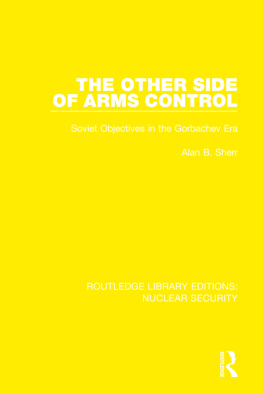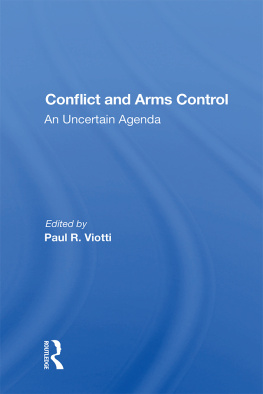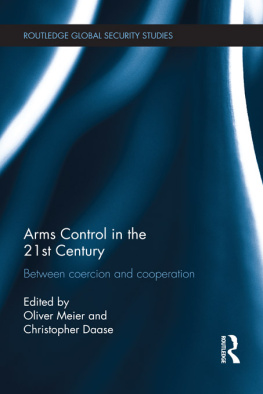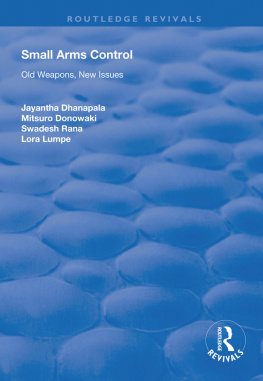Robert E. Williams Jr. is a professor of political science at Pepperdine University, Malibu, California.
Paul R. Viotti is a professor in the Josef Korbel School of International Studies and executive director of the Institute on Globalization and Security (IGLOS), University of Denver.
Arms Control
History, Theory, and Policy
Volume 1: Foundations of Arms Control
Robert E. Williams Jr. and Paul R. Viotti

Library of Congress Cataloging-in-Publication Data
Arms control : history, theory, and policy / Robert E. Williams Jr. and Paul R. Viotti, editors.
p. cm. (Praeger security international)
Includes index.
ISBN 978-0-275-99820-2 (hbk. : alk. paper) ISBN 978-0-275-99822-6 (v. 1 : alk. paper) ISBN 978-0-275-99824-0 (v. 2 : alk. paper) ISBN 978-0-275-99821-9 (ebook) 1. Arms control. 2. Arms controlHistory. 3. Security, International. I. Williams, Robert E., 1959 II. Viotti, Paul R.
JZ5625.A753 2012
327.174dc23 2011035539
ISBN: 978-0-275-99820-2 (set)
978-0-275-99822-6 (v. 1)
978-0-275-99824-0 (v. 2)
EISBN: 978-0-275-99821-9
16 15 14 13 12 1 2 3 4 5
This book is also available on the World Wide Web as an eBook.
Visit www.abc-clio.com for details.
Praeger
An Imprint of ABC-CLIO, LLC
ABC-CLIO, LLC
130 Cremona Drive, P.O. Box 1911
Santa Barbara, California 93116-1911
This book is printed on acid-free paper 
Manufactured in the United States of America
We dedicate these volumes on arms control to two of our mentors: Inis Claude, who did pioneering work on collective security and international organization, and Kenneth Waltz, who, as president of the American Political Science Association, helped one of us organize its international security section.
Contents
1 Introduction: Arms Controls Third Era
Robert E. Williams Jr.
2 A Template for Understanding Arms Control
Paul R. Viotti
3 Elements of a General Theory of Arms Control
Patrick M. Morgan
4 Arms Control and International Law
Robert E. Williams Jr.
5 The Philosophical Underpinnings of Arms Control
Michael O. Wheeler
6 Creative Spirit: The Self as a Force for Human Survival
Alexander Blackburn
7 Deterrence, Nonproliferation, and Disarmament: The Nuclear Conundrum
Alan J. Parrington
8 Arms Control in the Human Security Paradigm
Zaryab Iqbal
9 Conflict Resolution
Karen A. Feste
10 Anthropology and Arms Control
Pauletta Otis
11 Approaches to Arms Control Simulations: A Primer on Game Theory, Agent-Based Modeling, and Landscape Dynamics
Paul R. Viotti Jr.
12 NGOs, Social Movements, and Arms Control
Jeffrey W. Knopf
13 NGOs and Arms Control Processes
Mark E. Donaldson
14 Arms Control and Nuclear Weapons
James J. Wirtz
15 Strategic Arms Control since World War II
Jeffrey A. Larsen
16 The Perils of Arms Control: The Lessons of Naval Arms Limitation during the Interwar Years
Robert G. Kaufman
17 The Convention on Cluster Munitions
Bonnie Docherty
18 The Control of Landmines and Other Explosive Remnants of War
Kenneth R. Rutherford
Bertha von Suttner
Roger Alford
Woodrow Wilson
Calvin M. Scott
Nicholas II
Benjamin M. Young
Bertrand Russell
Russell A. Burgos
J. Robert Oppenheimer
Emerson Siegle
Thomas C. Schelling
Rebecca Glazier
Andrei Sakharov
Benjamin M. Young
Hedley Bull
Russell A. Burgos
Helen Caldicott
Matthew G. Miller
Mohamed ElBaradei
Russell A. Burgos
Randall Forsberg
Scott A. Miller
Jody Williams
Russell A. Burgos
Mikhail Gorbachev
Calvin M. Scott
Acknowledgments
In a work of this nature, the editors owe an enormous debt to those individuals who, in spite of busy schedules and other obligations, agreed to lend their expertise by contributing chapters or other elements of a project that may have seemed to be of uncertain value when the first conversations occurred. By agreeing to contribute, and by doing so with great professionalism, the authors have made these volumes valuable, and for this we are grateful.
Julia Steggerda compiled the list of acronyms that appears as an appendix, handling the task as if she were being well compensated. (In fact, she wasnt.) Bob Escudero and Chris Low graciously assisted with a variety of technical tasks related to the preparation of the manuscript. We, perhaps, could have done it without them, but it wouldnt have been pretty.
Steve Catalano at Praeger Security International was the editor that every academic author would like to have but very few deserve. We both appreciate his encouragement, his advice, and, of course, his patience.
We dedicate these volumes to two mentors who challenged us in the international relations and security studies weve made a central part of our professional livesInis L. Claude, Jr. (Robert) and Kenneth N. Waltz (Paul). Our intellectual debts to them can never fully be repaid.
We acknowledge the exchanges that weve had over the years with our children: Daniel and Stephen (Roberts) and Michelle, David, and Paul Jr. (Pauls). They have responded not just with patient acceptance of our excitement over what to many would seem arcane topics, but with contributions to the discourse as well.
Finally, we owe our biggest debts of gratitude to our wives, Sandy Harrison and Linda Viotti. They know why.
Robert E. Williams Jr.
Malibu, CA
Paul R. Viotti
Honolulu, Hawaii
PART I: AN INTRODUCTION TO ARMS CONTROL
CHAPTER 1 Introduction: Arms Controls Third Era
Robert E. Williams Jr.
Robert E. Williams Jr. is a professor of political science at Pepperdine University, Malibu, California.
A look back at the past century suggests that we may now be at the beginning of a third major era in the theory and practice of arms control. According to this way of assessing the modern history of arms control, the first of these three eras began with World War I. As a consequence of what that generation called the Great War, there developed the conviction that armaments were the problem (or at least a significant part of it) and, as a result, that disarmament had to be the solution. The League of Nations Covenant, with its call for reduction of national armaments to the lowest point consistent with national safety and the enforcement by common action of international obligations, exemplified this belief that disarmament was an essential component of the quest for order in the international system. But so, too, did the Washington Naval Conference of 19211922, which produced an agreement to limit naval expansion; the 1925 Geneva Protocol, which prohibited the use of chemical and bacteriological weapons; and the report of the Nye Committee in the United States Senate, which, in 1936, concluded that weapons manufacturers had been instrumental in leading the United States to war in 1917.











